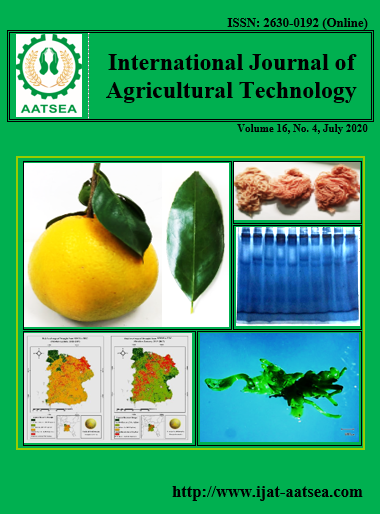Investigation of microbial pigment production and its assessment of wool fiber dyeing
Main Article Content
Abstract
The production of natural red pigment using the filamentous fungus Pencillium purpurgenium under different growth forms of inocula (mycelia and spores) was investigated. Meanwhile, different physiological condition involving magnesium sulphate concentration, inoculums size and different age as well as some additives were tested. The results showed that the specific production of pigment was obtained by using mycelia as inocula, the yield increased by 30.08% as compared to spore form. The study extended to dye wool fibers with the extracted pigment using innovation technique to save energy and time. In order to obtain color of aimed specific red hue, the influence of certain dyeing process condition namely dyestuff concentration, pH, temperature, and duration of the dyeing process has been reported.
Article Details

This work is licensed under a Creative Commons Attribution-NonCommercial-NoDerivatives 4.0 International License.
References
Alexandra, N., Lucas, C. and Cecilra, O. (1999). Transport and utilization of hexoses and pentoses in the halotolerant yeast Debryomyces fansenti. Applied and Environmental Microbiology, 65:3594- 3598.
Ali, N. F. and Abd- Elsalam, I. S. (2020). Antimicrobial characteristics of wool fibers treated with chitosan-propolis nano composite and dyed with natural dye extracted from Red Prickly Pear. International Journal of Agricultural Technology, 16:223-236.
Ali, N. F. and El-Mohamedy, R. S. R. (2011). Eco-friendly and protective natural dye from red prickly pear (Opuntia Lasiacantha Pfeiffer) plant. Journal of Saudi Chemical Society, 15:257-261.
Ali, N. F., El-Khatib, E. M., El-Mohamedy, R. S. S. and Ramadan, M. A. (2014). Antimicrobial activity of silk fabrics dyed with saffron dye using microwave heating. International Journal of Current Microbiology and Applied Sciences, 3:140-146.
Clark, D. E., Gac, F. D. and Sutton, W. H. (1998). Microwaves: theory and application in materials processing, ceramic transactions, 21, Westerville. The Journal of the American Ceramic Society, 451-458.
Eman, F., Wail, A., Marwa, A., Salwa, I. and Abd-Elsalam, I.S. (2018). Wool and Silk Fabric dyeing by Mannitol –assisted pigment produced from Penicillium purpurgenium. Der pharma Chemica, 10:166-175.
Ferruzzi, M. and Schwartz, S. (2005). Thermal degradation of commercial grade sodium copper chlorophyllin. Journal of Agricultural and Food Chemistry, 53:7098- 7102.
Griffin, D. H. (2000). Fungal physiology, Wiley liss New York, USA.
Herrero, M. A, Kremsner, J. M. and Kappe, C. O. (2008). Non-thermal microwave effects revisited: on the importance of internal temperature monitoring and agitation in microwave chemistry. The Journal of Organic Chemistry, 73:36-47.
Jakovijevic, V. D, Millicevic, J., Stojanovic, D., Solujic, S. and Vrvic, M. (2014). Antioxidant activity of ethanolic extract of Penicillium chrysogenum and Penicillium funiculosum. Hemijska industrija, 68:43-49.
Joshi, V. K., Attri, D., Bala, A. and Bhushan, S. (2003). Microbial pigments. Indian Journal of Biotechnology, 2:362-369.
Moore, S. B. and Ausley, L. W. (2004). Systems thinking and green chemistry in the textile industry: concepts, technologies and benefits. Journal of cleaner production, 12:585-601.
Morales, L., Oliveira, M., Sousa, C., Mendez, Z. and Montariez, J. (2015). Quantitative assessment of the impact of the type of inoculum on the Kinetic of cell growth substrate consumption and pigment productivity by penicillium purpurgenum GH2 in liquid culture with an integrated stochastic approach. Food and Bio-products processing, 96:221-231.
Nagia, F. A. and El- Mohamedy, R. SR. (2006). Dyeing of wool with natural anthraquinone dyes from Fusarium oxysporum. Dyes and pigments, 1-6.
Papagianni, M. and Moo-Young, M. (2002). Protease secretion in gluco-amylase producer Aspergillus niger culture fungal morphology and inoculums effects, Process Biochemistry, 37:1271-1278.
Santos –Ebinuma, V., Teixeria, M. and Pessoa, A. (2013). Submerged culture condition for the production of alternative natural colorant by a new isolated Pencillium pupergenium DPUA 1275. Journal of Microbiology and Biotechnology, 23:802-810.
Tulli, H., Chaundhary, P., Benival, V. and Shama, A. K. (2014). Microbial pigment as natural color sources. Current trends an future prospective. Journal of Food Science and Technology, 52:4669-4678.
Van der Toorn, F., de Mutsert, R., Lijfering, W. M., Rosendaal, F. R. and van Hyickama Vlieg, A. (2019). Glucose metabolism affects coagulation factors: the NEO study. Journal of Thrombosis and Haemostasis, 17:1886-1897.
Zhang, C., Liao, L. and Gong, S. (2007). Recent developments in microwave-assisted polymerization with a focus on ring-opening polymerization. Green Chemistry, 9:303-314.


